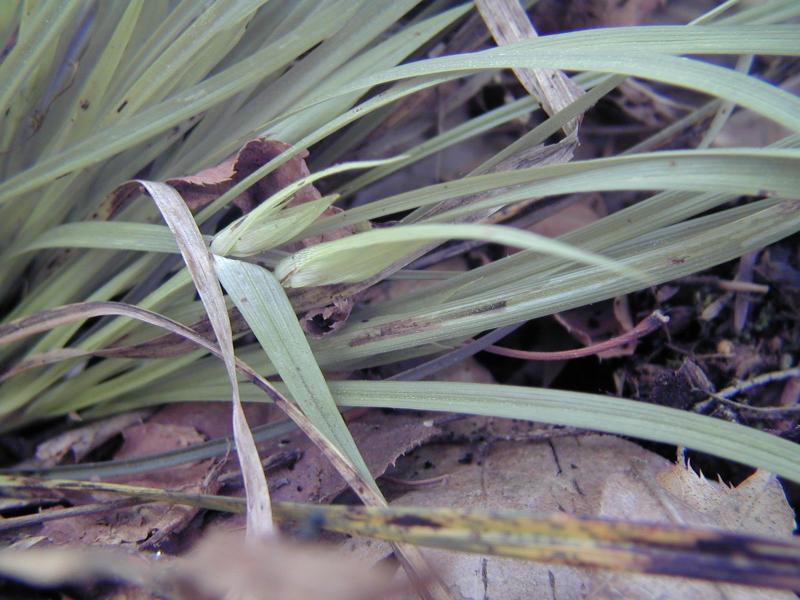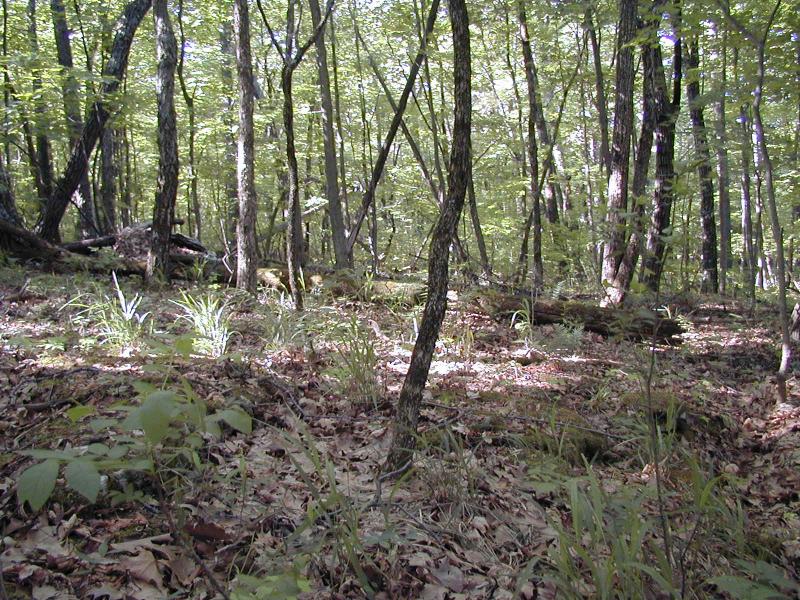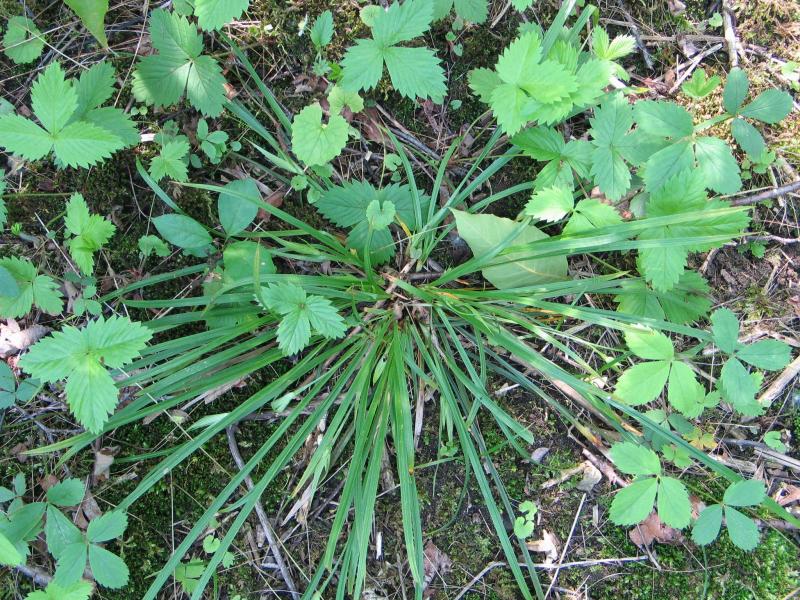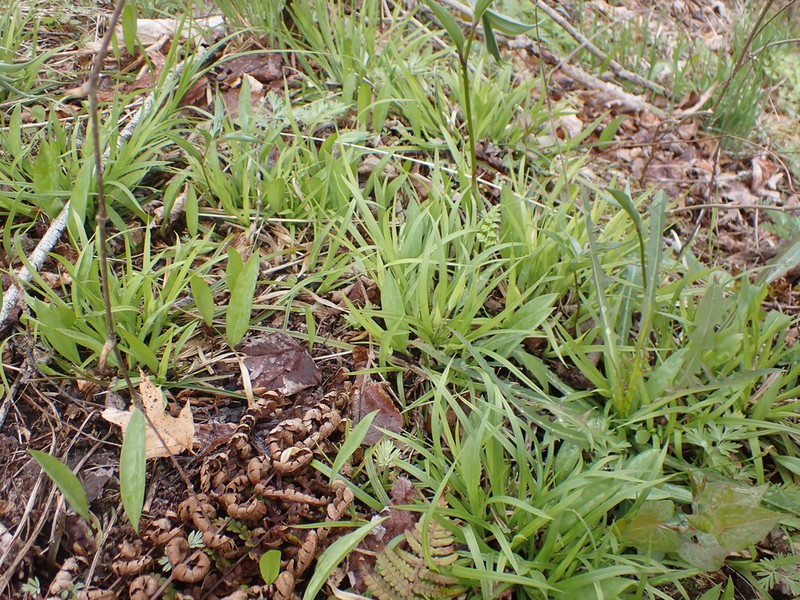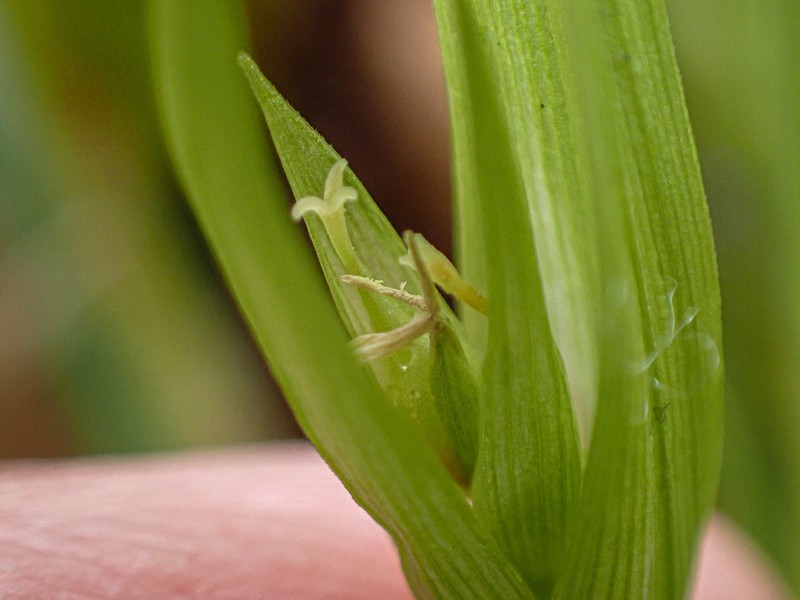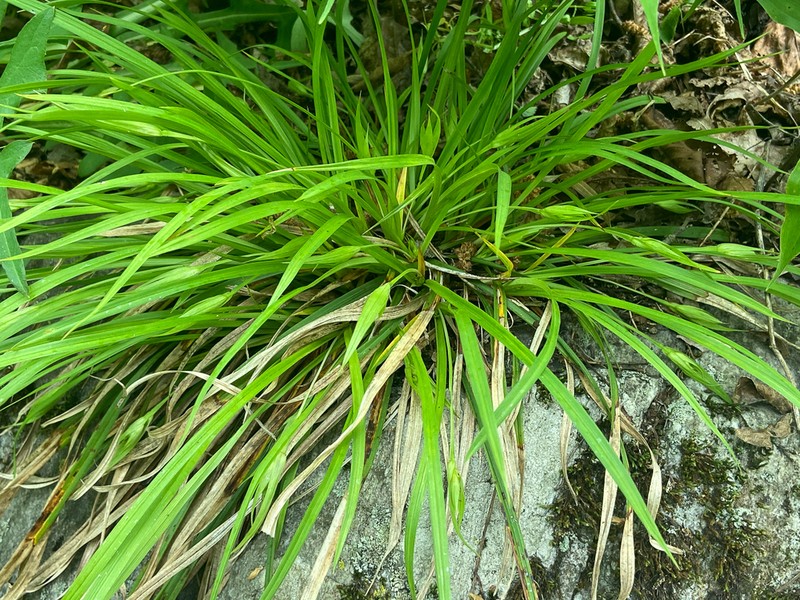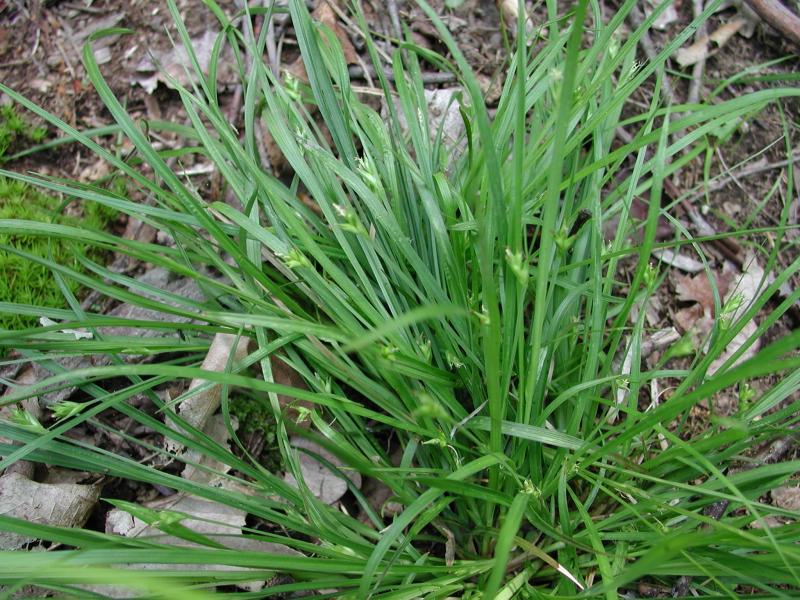Back's Sedge
Carex backii Boott
- Class
- Monocotyledoneae (Monocots)
- Family
- Cyperaceae (Sedge Family)
- State Protection
- Rare
A plant listed as Rare by New York State. Removal or damage without the consent of the landowner is prohibited.
- Federal Protection
- Not Listed
- State Conservation Status Rank
- S3
Vulnerable in New York - Vulnerable to disappearing from New York due to rarity or other factors (but not currently imperiled); typically 21 to 80 populations or locations in New York, few individuals, restricted range, few remaining acres (or miles of stream), and/or recent and widespread declines.
- Global Conservation Status Rank
- G5
Secure globally - Common in the world; widespread and abundant (but may be rare in some parts of its range).
Summary
Did you know?
Back's sedge was first discovered in Connecticut in 1988 (Mehrhoff 1995), Massachusetts in 1997 (Bertin et. al 2002), and the southern Finger Lakes area of New York in 2004 (Werier 2004). Some think it has been overlooked due to its inconspicuous nature. The species is named in honor of Sir George Back (1796-1878).
State Ranking Justification
There are currentlyover 21 known populations of Carex backii and approximately ten historical populations. This plant tends to prefer wooded sites with a shallow limestone bedrock. Since this is a somewhat specific requirement, habitat options are limited. Invasive species may pose a threat, but for now this threat has had minimal impacts. There are real concerns that swallowwort (Cynanchum spp.) will reduce or eliminate a few populations.
Short-term Trends
About ten new locales for Carex backii have been found in the past 20 years. With a limited season to easily identify this plant and as an inconspicuous plant, these new locales probably represent populations that have been overlooked in the past. Approximately ten additional populations have not been seen in over 20 years but searches to most of these sites have not been conducted and original site location information is obscure. Of populations that have been documented more than once there does not appear to be any clear trends. As a speculative trend, the trend of this plant appears stable. Some may argue there is an increase in range, but this could just reflect overlooked populations.
Long-term Trends
A few populations have been known for over 50 years but clear data on trends for these populations is lacking.
Conservation and Management
Threats
Overall most populations are not threatened. Exotics are currently and could potentially threaten a few sites. Trampling and human disturbances such as dumping, logging, and residential development are also potential threats at a couple of sites. Most of these threats are speculative and might not have a negative impact on populations.
Conservation Strategies and Management Practices
At a few sites, if feasible, exotics including swallowwort (Cynanchum sp.) should be controlled. Trampling by ATV's and foot traffic should be monitored and restricted if necessary.
Habitat
Habitat
This sedge grows primarily in dry, rocky deciduous, mixed, or evergreen open forests or woodlands, often over limestone. It occurs on or adjacent to rocky ledges, rock outcrops, ridges, calcareous pavement barrens and woodlands, thickets, and sand plain thickets. Open canopied forests are preferred but it also grows in more forested as well as more open habitats. (New York Natural Heritage Program 2005). Dry, rocky, open, or shaded slopes, ridges, and barrens, in hardwood, mixed, or coniferous forests, including pine plantations, on acidic and calcareous substrates (Crins et al. 2002). In quite varied habitats, the species frequently occurs in mesic deciduous forests near streams and rivers. Soils often have a high organic content with an abundance of leaf litter. Signs of localized, natural disturbance are usually evident. It also grows in open, prairie habitats with scattered Quercus macrocarpa, on open granite outcrops, and along disturbed roadsides (Saarela and Ford 2001). Dry rocky or sandy woods and bluffs (Fernald 1970).
Associated Ecological Communities
- Alvar pavement grassland
(guide)
This community consists of exposed, flat limestone or dolostone pavement with grassy or mossy patches interspersed throughout. Some examples may be solely grassland with no pavement.
- Alvar shrubland
(guide)
A shrub-dominated community that has over 25% cover of tall, short, and dwarf shrubs. There are often deep crevices or grikes in the limestone pavement; trees and shrubs are often rooted in the grikes.
- Alvar woodland
(guide)
A subset of the limestone woodland community restricted to the alvar region in Jefferson County, New York.
- Appalachian oak-hickory forest
(guide)
A hardwood forest that occurs on well-drained sites, usually on ridgetops, upper slopes, or south- and west-facing slopes. The soils are usually loams or sandy loams. This is a broadly defined forest community with several regional and edaphic variants. The dominant trees include red oak, white oak, and/or black oak. Mixed with the oaks, usually at lower densities, are pignut, shagbark, and/or sweet pignut hickory.
- Calcareous cliff community
(guide)
A community that occurs on vertical exposures of resistant, calcareous bedrock (such as limestone or dolomite) or consolidated material; these cliffs often include ledges and small areas of talus.
- Calcareous shoreline outcrop
(guide)
A community that occurs along the shores of lakes and streams on outcrops of calcareous rocks such as limestone and dolomite. The vegetation is sparse; most plants are rooted in rock crevices.
- Limestone woodland
(guide)
A woodland that occurs on shallow soils over limestone bedrock in non-alvar settings, and usually includes numerous rock outcrops. There are usually several codominant trees, although one species may become dominant in any one stand.
Associated Species
- Abies balsamea (balsam fir)
- Acer saccharum (sugar maple)
- Boechera laevigata
- Carex blanda (eastern woodland sedge)
- Carex molesta (troublesome sedge)
- Carex pensylvanica (Pennsylvania sedge)
- Carex rosea (common upland star sedge)
- Carex umbellata (parasol sedge)
- Carya ovata
- Cornus racemosa (gray dogwood, red-panicled dogwood)
- Crataegus sp.
- Diervilla lonicera (bush-honeysuckle)
- Juniperus virginiana
- Luzula multiflora
- Ostrya virginiana (hop hornbeam, ironwood)
- Pinus strobus (white pine)
- Quercus alba (white oak)
- Quercus macrocarpa (bur oak)
- Quercus rubra (northern red oak)
- Thuja occidentalis (northern white cedar, arbor vitae)
- Toxicodendron radicans ssp. radicans (eastern poison-ivy)
- Waldsteinia fragarioides
- Zanthoxylum americanum (prickly-ash)
Range
New York State Distribution
This sedge occurs in eastern New York from Dutchess County north. It also occurs in northern New York and there are two records from central New York (Onondaga and Tompkins Counties).
Global Distribution
A north temperate and boreal species Carex backii is most frequent in the Great Lakes region as well as the prairie provinces. It is quite infrequent in the extreme western and eastern part of its range. Overall, this sedge ranges from the Gaspé peninsula in eastern Quebec and southeastern New Brunswick west through Ontario, Manitoba, Saskatchewan, Alberta, and British Columbia south to New England, New Jersey (one historical population), Pennsylvania (one historical population), Michigan, Minnesota, North Dakota, and northwestern Montana with disjunct populations in western South Dakota, Wyoming, and Colorado (Rhoads and Klein 1993, Saarela and Ford 2001, Snyder 2001).
Identification Comments
General Description
A densely tufted grass-like plant, this sedge has leaves 1.3-5.4 mm wide. The leaves are up to 37 cm long and the whole plant often appears somewhat flattened. The flowers and fruits, which occur in clusters 0.7-1.6 cm long, are borne on the tips of stalks which are shorter than the leaves. The flowers and fruits are inconspicuous because they are completely concealed by leaf like structures (scales) which surround each individual flower/fruit in a cluster. The best way to look for this plant is to search for these leafy scales.
Identifying Characteristics
This cespitose (growing in tufts or clumps) Carex with relatively short rhizomes (<3.0 mm long) has dull-green to yellow-green, plicate to flat leaves which are 1.3-5.4 mm wide. The reproductive shoots produce one terminal spike on apically dilated culms which are 1.4-24.9 cm long. At the base of the culms, arise 0-3 basal spikes, which are terminal on elongate peduncles. The spikes are androgynous with 2-3 staminate and 2-7 pistillate flowers. The spikes are not subtended by bracts. The pistillate flowers/perigynia are subtended by leaf-like scales which completely surround them. The lowest scale of the terminal spike is 1.9-7.2 cm long and 2.0-6.5 mm wide. The more distal scales become gradually reduced in size. Perigynia are 4.8-6.6 mm long and gradually taper to an elongated beak 1.9-2.9 mm long.
Best Life Stage for Proper Identification
This species can be identified in flower although fruiting characteristics are best. A complete reproductive shoot with mature perigynia should be collected to verify the identification.
Similar Species
In New York there are two (Carex jamesii and C. willdenowii) and perhaps a third (C. juniperorum) species that are somewhat closely related and similar morphologically. Carex backii can be distinguished from all three by its wider pistillate scales (2-6.5 mm wide compared to 1.6-2.22 mm for C. willdenowii, 1.4-3.0 mm for C. jamesii, and 1.2-3.0 mm for C. juniperorum) which completely conceal the perigynia in C. backii as compared to not concealing the perigynia in these other species. These scales and particularly the upper scales have narrow hyaline or green margins in C. backii as well as C. juniperorum but have broad hyaline margins in C. willdenowii and C. jamesii. Carex backii also has 2-3 staminate flowers per terminal spike as compared to 3-29 for C. willdenowii, 3-13 for C. jamesii, and 5-21 for C. juniperorum. In addition, C. backii has clavate, minutely papillose stigmas as compared to filiform, strongly papillose stigmas of C. willdenowii, C. jamesii, and C. juniperorum.
Best Time to See
The species is in fruit from late May to mid July although fruits are shedding by the end of this season making identification more complicated at this time. Surveys for this species should be done from late May through June.
- Fruiting
The time of year you would expect to find Back's Sedge fruiting in New York.
Back's Sedge Images
Images of Similar Species
Taxonomy
Back's Sedge
Carex backii Boott
- Kingdom Plantae
- Phylum Anthophyta
- Class Monocotyledoneae
(Monocots)
- Order Cyperales
- Family Cyperaceae (Sedge Family)
- Order Cyperales
- Class Monocotyledoneae
(Monocots)
- Phylum Anthophyta
Additional Common Names
- Rocky Mountain Sedge
- Sedge
Synonyms
- Carex durifolia Bailey
Comments on the Classification
The closely related species Carex saximontana (from the Great Plains) has sometimes been considered a synonym of C. backii (e.g. Gleason and Cronquist 1991). Recent work has shown that the two are distinct and that a third recently described species, C. cordillerana (from west of the Rockies), may have led to previous confusion regarding the distinctiveness of C. saximontana (Saarela and Ford 2001).
Additional Resources
Best Identification Reference
Crins, W.J., R.F.C. Naczi, A.A. Reznicek, and B.A. Ford. 2002. Carex Linnaeus sect. Phyllostachyae Tuckerman ex Kükenthal. Pages 558-563 in Flora of North America Editorial Committee (editors), Flora of North America, north of Mexico, Volume 23, Magnoliophyta: Commelinidae (in part): Cyperaceae. Oxford University Press, New York, New York, USA. 608pp + xxiv.
Other References
Bertin, R.I., K.B. Searcy, and P. Somers. 2002. A new native plant for Massachusetts, Carex backii (Cyperaceae). Rhodora 104(918): 201-204.
Fernald, M.L. 1950. Gray's manual of botany. 8th edition. D. Van Nostrand, New York. 1632 pp.
Flora of North America Editorial Committee. 2002. Flora of North America, North of Mexico. Volume 23. Magnoliophyta: Commelinidae (in part): Cyperaceae. Oxford University Press, New York. 608 pp.
Gleason, Henry A. and A. Cronquist. 1991. Manual of Vascular Plants of Northeastern United States and Adjacent Canada. The New York Botanical Garden, Bronx, New York. 910 pp.
Holmgren, Noel. 1998. The Illustrated Companion to Gleason and Cronquist's Manual. Illustrations of the Vascular Plants of Northeastern United States and Adjacent Canada. The New York Botanical Garden, Bronx, New York.
Merhoff, L.J. 1995. Additions to the preliminary checklist of vascular flora of Connecticut. Rhodora 97(889): 9-38.
Mitchell, Richard S. and Gordon C. Tucker. 1997. Revised Checklist of New York State Plants. Contributions to a Flora of New York State. Checklist IV. Bulletin No. 490. New York State Museum. Albany, NY. 400 pp.
New York Natural Heritage Program. 2010. Biotics database. New York Natural Heritage Program. New York State Department of Environmental Conservation. Albany, NY.
New York Natural Heritage Program. 2024. New York Natural Heritage Program Databases. Albany, NY.
Rhoads, Ann F. and Timothy A. Block. 2000. The Plants of Pennsylvania, an Illustrated Manual. University of Pennsylvania Press, Philadelphia, PA.
Saarela, J. M. and B. A. Ford. 2001. Taxonomy of the Carex backii Complex (Section Phyllostachyae, Cyperaceae). Systematic Botany 26(4): 704-721.
Weldy, T. and D. Werier. 2010. New York flora atlas. [S.M. Landry, K.N. Campbell, and L.D. Mabe (original application development), Florida Center for Community Design and Research http://www.fccdr.usf.edu/. University of South Florida http://www.usf.edu/]. New York Flora Association http://newyork.plantatlas.usf.edu/, Albany, New York
Werier, D.W. 2004. Carex backii (Back's sedge) a new native species for the southern Finger Lakes Region of New York. Solidago: The Newsletter of the Finger Lakes Native Plant Society 5(3): 4-5.
Links
About This Guide
Information for this guide was last updated on: November 4, 2022
Please cite this page as:
New York Natural Heritage Program. 2024.
Online Conservation Guide for
Carex backii.
Available from: https://guides.nynhp.org/backs-sedge/.
Accessed July 27, 2024.
